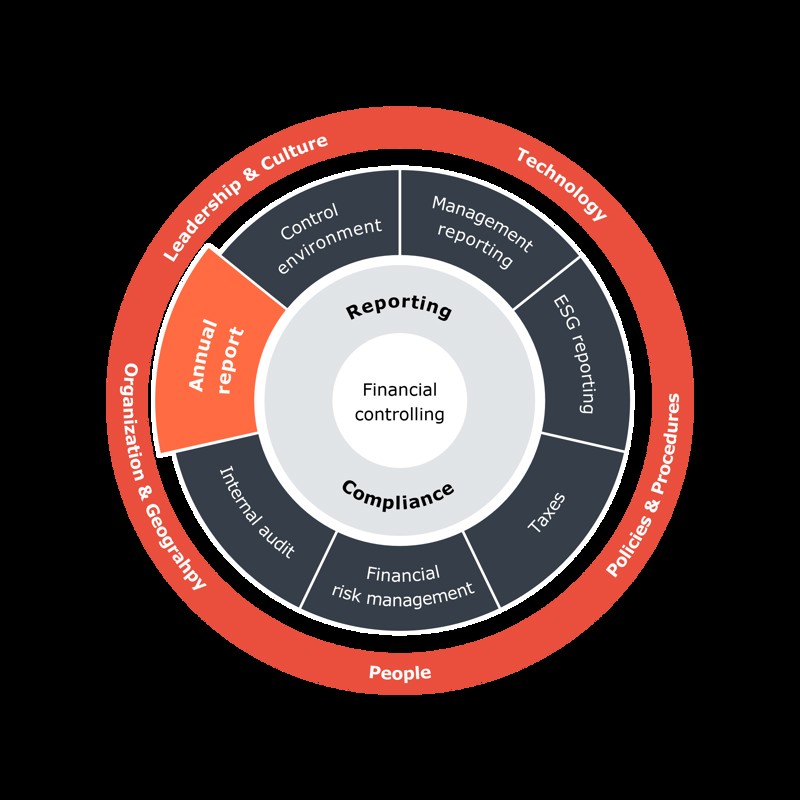There are significant advantages to starting the annual report preparation process well in advance. Both in terms of optimising your resources, better stakeholder management and reducing the risk of surprises when dealing with particular risk areas. But how do you best plan the creation of the annual report? You can learn more about that in this article.
When preparing the annual report, many stakeholders and parts of the organisation are at play. The process covers a long series of technically focused tasks in Finance, involves other departments and possibly external advisers for the communication, as well as relevant decision-makers.
A well-planned process can therefore be of crucial importance for ensuring that resources are used most appropriately. It gives your employees better conditions for the preparation, helps to keep the audit fee to a minimum, just as the internal communication to the company's stakeholders becomes more credible.
Perhaps your company's activities, key people, accounting rules and timeline are unchanged from last year, but we recommend that you nevertheless revisit the plan and not least the experiences from last year.
Identify the stakeholders and their expectations
Management is the formal issuer of the annual report, and therefore they are the most significant stakeholder for the Finance department's task of preparing it. It's therefore important that you clarify the expectations for the task as early as possible in terms of time consumption, quality and support for the CFO's needs in managing the other stakeholders (particularly the CEO and the board).
The planning should also include consideration of any impacts from more strategic matters. For example, is there a need for voluntary changes in applied accounting policies or presentation currency, does a full conversion to another accounting framework need to take place (e.g. from the Danish Financial Statements Act to IFRS) etc.?
The involvement of external advisers also needs to be agreed early in the process, as it can have significant impact on both the timeline and resource consumption. A good plan for collecting reporting packages from subsidiaries is also essential, as this is often an area where delays can threaten the overall timeline.
Legislation, deadlines and resource planning
In Denmark, the annual report must be submitted to the Danish Business Authority no later than six months after the balance sheet date. For listed companies, the deadline is four months. In addition to the legislative requirements, it's important to define internal deadlines for each phase of the annual report process, from completion of the bookkeeping to management's and the auditor's signature.
It's important that you create an overview of each individual component in the process, after which you can estimate the necessary resource requirements. To identify any shortfalls in the necessary resource requirements, it can be a good idea to work backwards based on the desired deadlines.
Here you need to consider both the external and internal deadlines, as otherwise you won't be able to assess how they harmonise with each other.
Furthermore, it's essential to distinguish between deadlines derived from the stakeholders and deadlines derived from the parties involved in carrying out the actual work associated with the annual report, which will typically be finance, marketing, ESG specialists and subsidiaries. If the company is part of a larger group, the timeline may also be affected by a higher-level parent company.
Stay on top of operational deadlines
Whilst the deadlines that come from both internal and external stakeholders, such as the auditor, the Danish Business Authority and the board, rarely give rise to challenges, the operational deadlines can often prove problematic to meet. This can be due to the time aspect being underestimated, that for example the actual execution, the review and the follow-up on this take longer than calculated, or that the preparation of the template and presentation of the annual report in general should have been outsourced.
Based on the breakdown of the annual report's elements, responsible persons should be allocated to both the execution and the approval, and an estimate of the time consumption should be prepared. In connection with this, a thorough expectation alignment should be carried out with each individual person on what they are to execute and what output it should result in.
What can you learn from last year's process?
It can be a good idea to start by revisiting last year's process for the year-end closing – unless this evaluation was carried out immediately afterwards the year before, which is highly recommendable. This way you can ensure that the mistakes from the previous year are not repeated. In practice, this is best achieved through a good evaluation process where representatives of all significant parties involved in the annual report process are brought together. However, this does not apply to the auditor.
The purpose is to identify the elements that created delays or problems and ensure that these are handled better next time. A structured agenda for the evaluation meeting can be beneficial to ensure that all necessary topics are discussed.
A good example of an agenda for the evaluation meeting could look like this:
1. Opening remarks from the CFO/Head of Accounting
2. The planning process:
- Was the timeline realistic? If not, where should it be adjusted?
- Should the work tasks be distributed differently due to timelines, competencies etc.?
- Were there challenges with certain accounting items, and what did these consist of?
- Summary of learning points.
3. The execution process:
- Estimated time vs. task – what challenges arose, and can certain tasks be accelerated due to time pressure or professional uncertainty?
- How did the internal dialogue and sparring work along the way?
- Summary of learning points.
4. The closing process:
- How did the collection of sections from departments other than finance for the management report work?
- How did the circulation of the draft annual report go?
- How were comments from management handled, including updates and sharing of new drafts?
- How were comments from the auditor handled, including updates and sharing of new drafts?
- Summary of learning points.
5. What can we do differently and better with a view to the upcoming new annual report and its planning?
Are there changes in your accounting class?
The Danish Financial Statements Act regulates all commercial enterprises and is built around a so-called "building block model" that defines which rules a company, depending on its size, is subject to regarding financial reporting, which is divided into four accounting classes: A, B, C or D. The accounting class you belong to depends on certain statutory size limits relating to net revenue, balance sheet total and average number of employees.
The central point here is that you need to consider whether you are exposed to a change in accounting class compared to last year, including determining whether there may have been changes in the legislation. It's important to note here that the size limits for all accounting classes were increased by approximately 25% with effect for annual reports approved after 1 June 2024. In practice, this means that the changes have effect from and including the 2024 annual report.
If you report under IFRS (voluntarily or under requirement), it's important to be aware that you are also subject to compliance with the IFRS Executive Order, which contains supplementary disclosure requirements.
Prepare for corporate social responsibility requirements
The requirements for the management report depend on your company's accounting class. The provisions of the Danish Financial Statements Act also apply supplementarily if you prepare accounts under IFRS for a Danish company.
In 2025, there have been a number of adjustments to the requirements for the management report, which for most companies will likely be considered relatively uncomplicated to fulfil; requirements have been added for discussion of intangible key resources (for accounting class C (large)), and requirements have been removed for description of knowledge resources and the company's external environmental impact (for accounting class C (large/medium)). There are also amended requirements for discussion of gender composition in commercial foundations and clarifications of what management positions comprise as well as a statement on policies for diversity (for accounting class D).
Finally, the size limits for the respective accounting classes have been increased, which may mean more lenient requirements for some companies. In addition, there are changes to sustainability reporting requirements.
The requirements for sustainability reporting have in recent years been difficult to decode and predict, as the EU's directive on sustainability reporting (CSRD) was initially introduced with a very extensive reporting burden, but after the first wave of reporting was put on hold for the vast majority of companies. In the intervening waiting period, the legislation and the associated reporting standards (ESRS) will be reduced significantly.
As it is still unknown how the requirements for sustainability reporting will ultimately look, we recommend that the waiting time be used to maintain the current effort in the area and focus on the business benefits rather than investing massively in preparing for the earlier scope of CSRD – which in all likelihood will become smaller. The preparation that can be done is to identify the company's most significant risks and opportunities and report on them in relation to the current ESRS. In two years' time, you will then be in a strong position by being familiar with the discipline whilst simultaneously being able to deliver what is already being requested by suppliers, banks, customers and other stakeholders.

How to best prepare for a hard close audit
Read more about hard close auditDefine the risk areas early
It's important to estimate the necessary resource requirements as early as possible to be able to identify where additional resources need to be added in the company.
By planning earlier in the year, you can create a smoother process for the year-end closing. The timeline often doesn't break down due to insufficient resources for the planned tasks, but due to unforeseen challenges where unresolved risk areas prove time-consuming to handle professionally, and not least where the effect of such matters needs to be clarified with stakeholders. An effective solution can be a hard close audit, which identifies and handles critical risk areas and significant accounting estimates well in advance, creating optimal conditions for an efficient year-end closing and annual reporting.


Would you like us to help prepare your annual report?
With more than ten years' experience planning annual reports - both from a company and auditor perspective - Martin Philip Beyer has gained extensive knowledge of the process. Therefore, he can help create the framework for preparing the annual report that perfectly suits your company.
Have you been inspired to plan the preparation of your annual report? Then give Martin a call.

 en
en
 da
da



